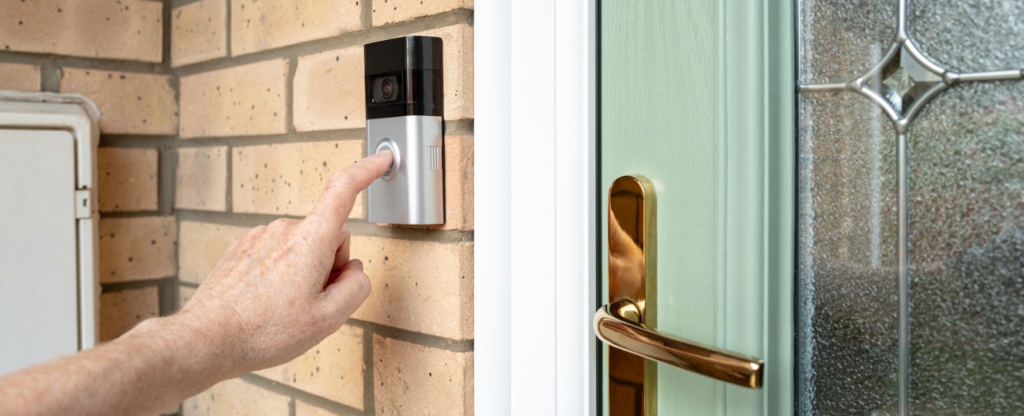October 30, 2024
Technology is all around us, even if we don’t always realize it. This article is part of an occasional series to highlight the innovative and interesting tech that we use every day—and the careers (and people) that make it work.

Smart doorbells are one example of smart home technology that is becoming increasingly more common and has significantly changed home security with user-friendly features.
Anything with a screen or buttons requires people working on user experience. This includes user interface teams that work to optimize how people interact with the product, engineers and programmers who build it, and people who test the functionality. Additionally, researchers and project managers work with the team to inform how a smart product’s interface should behave. People power technology and the products we depend on. Keep this in mind as we detail some of the technology behind smart doorbells, including:
- Live Video Recording and Remote Viewing
- Two-Way Communication
- Night Vision Capabilities
- Artificial Intelligence and Machine Learning
- End-to-End Encryption
- Live Video Recording and Remote Viewing
Smart doorbells’ built-in cameras stream live video of your doorstep to your smartphone or other connected devices. This allows you to see and communicate with visitors even while you’re away, providing your home with a boost in security. Remote monitoring is also particularly valuable with the rise of e-commerce, as it helps prevent package theft and verify deliveries.
Two-Way Communication
When someone rings the door or triggers the motion sensors, you’ll instantly receive a notification on your device. You can then open an app to speak with and hear the person. Whether it’s giving instructions to delivery workers, receiving important notifications or assisting family members who may need help at the door, you can seamlessly communicate with visitors in real-time, no matter your location. This feature can also deter potential intruders when no one is home, whether at work, on vacation, or running errands.
Night Vision Capabilities
Smart doorbells are designed with night vision capabilities to ensure surveillance at all hours. They capture clear, even full-colored footage in low-light conditions by using infrared (IR) light. This feature is useful for identifying details such as clothing color, vehicles and surroundings, typically being effective up to 30 feet. While invisible to the human eye, the camera’s IR LEDs emit light that bounces off objects and is then captured by the camera’s sensor to create clear images even in total darkness.
Artificial Intelligence and Machine Learning
More advanced models have implemented artificial intelligence (AI) and machine learning (ML) to better identify visitors by distinguishing between friends, family and strangers. Facial recognition is a key feature to recognize familiar faces and alert you if an unknown person approaches, ensuring timely alerts and improved security.
AI-powered voice assistants can generate responses on the fly, whether answering questions from visitors or delivering assertive messages to potential intruders. AI and ML also improve audio recognition, so that your doorbell can understand specific sounds like differentiating between dog barks and car horns to give you more accurate notifications. AI can also learn and adapt over time with predictive analysis, providing early warnings by predicting potential security threats after identifying vulnerabilities. It also assists in maintenance by forecasting when the doorbell needs servicing, ensuring reliability at all times.
End-to-End Encryption
End-to-end encryption guarantees that video footage is encrypted from the moment it’s captured until it reaches the intended recipient, such as a smartphone. This means that only the smartphone can receive and decrypt the video to view it. As a result, hackers cannot access the footage without having your personal mobile device, and even the company that sold the doorbell cannot view any footage. This level of encryption is crucial for maintaining user privacy and security, providing peace of mind.
Sources:
How-To Geek: What is a Smart Doorbell and Can It Protect Your Home? by Brent Dirks
Smart Home Ace: Smart Doorbells Explained: Features, Advantages, and Buying Guide by Richard Lakeford
Consumer Reports: Ring Expands Encryption to More Cameras, Doorbells, and Users by Daniel Wroclawski
Vivint Blog: Smart Home Essentials: Why a Wi-Fi Doorbell is a Must-Have
Tech Radar: This AI voice doorbell gives dynamic voice responses depending on who’s calling – and it can be as aggressive as you like by Cat Ellis
Praos: The Future of Home Security: Integrating AI and Smart Technology in Alarm Systems
Doorbell Planet 5 Best Solar Powered Video Doorbell: Ring Doorbell is #1